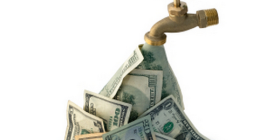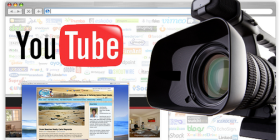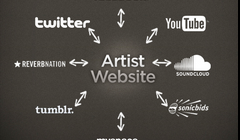For any product release, including a physical item such as a book, tech product, how-to video, CD, etc., an effective digital publicity campaign can be critical to your success. In any public relations effort, by maintaining consistency across all the digital channels you employ – including social media, the blogosphere, and your mailing list – you will not only promote your upcoming product, but the efforts in your pre- and post-release strategy can help build a stronger brand, grow your relevance and influence within your target market, and help to ensure the success of future product releases and promotions.
When it comes time to plan a PR campaign for an upcoming product release, there are several factors that need to be considered and properly executed. Let’s explore four of the more important assignments of a successful product release.
• Create a consistent content strategy
• Promote a strong brand
• Inform and excite your existing customer base
• Connect with niche influencers to generate a buzz with new customers
1. Create a consistent content strategy
The term “consistent” has two important meanings here. The first relates to the delivery of your content, the second to the perception of your brand (see #2).
Be it email newsletters or announcements made to your mailing list subscribers, videos posted to YouTube, photos posted to Instagram and Pinterest, or articles posted to your blog, planning your content so it is delivered with consistent frequency will help to build a regularly engaged customer base.
Knowing when to engage with your digital channels is important, and each has a time of day and week that is the most effective. According to a Buddy Media study published on Mashable.com, Facebook and Twitter posts are most engaged with on Saturdays and Sundays.
Graph from “Sorry, Marketers, You’re Doing Facebook Wrong” from Mashable.com
From the Mashable post:
“Weekends, when brands post too little, the audience appears primed for interaction, though it varies by industry. For ‘advertising and consulting,’ for example, weekend posts get 69% higher interaction, but only 11% of posts are published on Saturday and Sunday.”
Graph from “Sorry, Marketers, You’re Doing Twitter Wrong” from Mashable.com
One major difference between Facebook and Twitter is that Twitter is most effective when posting between 8 AM – 7 PM, while Facebook is most effective with posts published between 8 PM – 7 AM.
Newsletters have a similar timeframe as Facebook where people are most likely to open an email sent early in the morning, however they are most opened in the middle of the week, as you can see in this graph, courtesy of Mail Chimp.

It is important to note that while all these studies show trends across industries in general, your list and your followers will show their own patterns. These studies are good as a general guideline, but nothing beats data you’ve mined from your past email and social media efforts, and it is critical to amass this information over time and create a product release strategy catered to your audience and their engagement habits.
2. Promote a strong brand
The second meaning of “consistent” for us regards the theme of your content published across all your digital platforms. The more focused your content is, the more effectively it will reinforce your brand amid your product release promotions.
The theme of your content should reflect your primary goal for this campaign – to spread awareness of your upcoming product – but it should also reflect your overall brand as well. To do this, your blog posts, newsletter, videos, and images need to maintain the following:
1. Consistent color scheme and overall style
2. Consistent tone of voice and direction of messaging
3. Common goals (driving views to product preview video, newsletter sign ups for exclusive access, etc.)
There are numerous platforms for you to explore, including Facebook, Twitter, YouTube, Pinterest, Instagram, Tumblr, and many others. In order to maintain a consistent content strategy (in terms of delivery), you need to explore all of the options, determine which platforms cater to your target audience, and then choose carefully as to which you can realistically establish and maintain a presence on effectively. This depends on which channels you currently employ as well as the manpower you have available to monitor and maintain your campaign.
3. Inform and excite your existing customer base (and build customer loyalty)
Your mailing list subscribers are likely to be your most loyal “super fans” – the most likely to purchase from you – and offering them exclusive content surrounding a product release is a great way to fuel excitement while also building overall brand loyalty.
One way to integrate multiple platforms for communicating with your customers is to push email newsletter signups through Facebook and your website. Let your prospects and customers know your newsletter is touting exclusive content and discounts, and make it easy for them to sign up using an “e-for-m” (email for media) Facebook app and a widget on your website or blog. Most email services such as Fanbridge, Topspin Media, and Mail Chimp offer e-for-m widgets.
Make sure you state clearly that joining the mailing list means free, exclusive access delivered immediately upon joining, as well as further access to be received in future newsletters.
How often you send an email newsletter depends on how much relevant, new information you have to convey — or new exclusive content you have to give away — but the goal is to communicate frequently enough to retain your prospects’ interest while not communicating so frequently as to annoy and cause drop off. Monitoring your open rates and opt-outs (and your abuse rate) is a good way to gauge your list’s approval of your email frequency.
How much content you have to deliver will dictate how far in advance you should start your new product rollout to your mailing list. If you send a weekly email and have enough to include new, exclusive content in every newsletter starting two months out, then a two-month rollout can be the way to go. If you only have one piece of exclusive content for your upcoming release – like a free demo or a clip – time the release so you can do one major announcement, and then a follow-up with your exclusive content as a secondary addendum to your regular newsletter content.
4. Connect with niche influencers to generate a buzz with a new customer base
While catering to your existing customer base is a critical part of creating loyalty and a strong brand, a vital part of an effective product release PR strategy includes expanding your reach to new fans through market influencers.
While various niche influencers will have a strong presence on Facebook, Twitter, YouTube, and other social networking platforms, blogs are where more and more potential customers are seeking information and recommendations.

According to NM Incite, at this time last year, there were over 170 million blogs being tracked, many driven by passionate people focused on spotlighting and reporting on specific markets and the niches within.
A few select examples of strong niche-specific bloggers include:
• Mashable.com (social media)
• TechCrunch.com (tech)
• Hypebot.com (music industry news)
A great way to expand the awareness of your product release is to target niche-specific bloggers and offer them exclusive content or giveaways, behind-the-scenes access, or even a hosted product premier. This will give you the opportunity to expose your product to a new market of fans passionate about just the type of work you are doing.
There are several ways to find the right blogs to target, but there are a few guidelines to consider before beginning your search
What is your niche?
Be careful, the answer to this may surprise you. Let’s say you’re an author, so you’re thinking blogs about books or writing, right? Not necessarily. Dive into the content itself. If your book is about film production, then film production blogs are where you can best represent your knowledge and product, and where you will find the most opportunity to gain new customers.
How big is your company in comparison to the size of the blog?
Blogs are akin to traditional promotional outlets such as magazines and newspapers. Many of the bigger blogs are likely to cover only the biggest stories within an industry, so it is important you don’t spend too much time and energy trying to reach the biggest bloggers in the world if you don’t have a company or product big enough (within the industry) to be reported on.
Once you’ve answered these questions, you can begin your search. Here are a few easy ways to target niche bloggers:
• Google Blog Search
• Technorati
• Alltop.com
• Social Media (Twitter, Tumblr, YouTube)
Through each, you can search using keywords that are relevant to your niche (“film production,” “film making,” and “making movies” are all good using the example above), which will help you identify blogs that are discussing important trends, issues, and topics within your target market.
How do I best approach these bloggers?
The most important first step to effectively approach a blogger is to check their site for contact/submission guidelines. Like traditional media, bloggers are often inundated with emails from people contacting them about coverage on their site. Because of this, it is important to make sure that you reach out to the blogger in the specified way or risk being ignored.
If approaching through email, write a concise message about your product, what you’d like to discuss with the blogger in more detail (don’t overwhelm by asking too much in the introductory email), and make sure your message ties back to your connection to the niche that this blogger is covering.
Employing A Long-Term Strategy
While it may seem like the end-goal for an effective product release are the actual results seen on the release day itself, employing an ongoing digital PR strategy after your release is necessary for enduring success. Thankfully, putting the proper efforts into planning for consistency in your content, as well as identifying niche influencers, will help you to build the foundation needed for you and your company to reach your true end-goals: maintaining a strong brand, expanding your reach, and increasing your influence within the market.
via Discmakers








